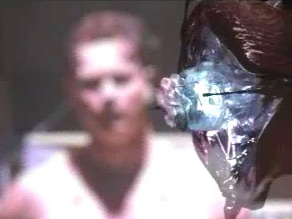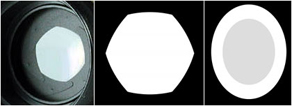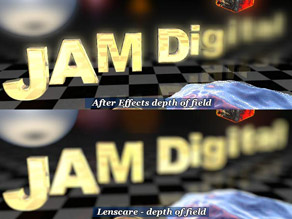Introduction
Lenscare moves depth of field and out of focus generation to post production.
If you need high quality camera blurs with the flexibility of 2d post
processing, Lenscare is a great choice. It can get you rid of
long extra 3d rendering times. The key aspect during the development of these filters
was to match the real thing as good as possible.
Lenscare is available as plugins for Adobe After Effects and Photoshop
compatible programs.
Depth of Field
Depth of field effects (dof) happen in all real optical devices to a certain
extent. It is heavily used in photography and film as a style element. In
computer graphics dof is usually generated using ray tracing techniques which
increase rendering times considerably. The depth of field plugin generates
those fast as a post process. It needs a depth buffer for its calculations.
Out of Focus
'Out of Focus' is
a fast version that works without depth information. It creates a blur with
constant radius over the complete image and is a good complement to 'Depth of
Field'. It offers some extra functionality as well. It's possible to use a
custom drawn lens in addition to the generateable ones. 'Out of Focus' also
offers background distortion for semi transparent areas.
 Fine use of Depth of Field in a fine short: Dronez
Fine use of Depth of Field in a fine short: Dronez
 Out of Focus used on live- and cgfootage in the movie Imposter.
Out of Focus used on live- and cgfootage in the movie Imposter.
A cameras blur looks substantially different from what common blur filters look
like. Among other differences Lenscare offers these features to help adding
realism:
Lens Aperture
A cameras lens aperture greatly defines the look of its blur (Bokeh). Therefore
the filters offer the possibility to alter the lens apertures form to simulate
several kinds of real cameras. This is important if you want to comp cg
elements into real footage or just want your cg shot to fit in with the rest. A
wide range of apertures can be simulated. The Out of Focus plugin provides the
possibility to completely replace the aperture with a custom image. The
aperture's form is most apparent in highlight spots.
Highlights
In reality very bright image parts are predominant when being out off focus
(see image below). Unfortunately common graphic formats cut of bright parts.
Thus the plugins offer the possibility to select parts that are supposed to be
brighter and give those boost.
Background Distortion
This is only available in 'Out of Focus'. When looking through a blurred object
the background is distorted due to that object. This effect is not very
apparent. But slight distortions help adding to the believability of your comp.
To experience this effect try holding your finger in front of your eye so that
it is out of focus. Now look through the blurred region on whatever is behind.
Move your finger around slightly to see the effect better.
 Lenscare offer lots of options to adjust Lens Apertures to match specific looks.
Lenscare offer lots of options to adjust Lens Apertures to match specific looks.
Gaussian and fast blurs can't produce highlights like these. Lenscare can (try rollover).
Subtile background distortions add beliveablility. Especially on moving footage (try rollover).
Apart from its speed and quality, an important advantage of a depth of field
post filter is that you are able to test various focus settings easily without
re-rendering the whole scene. That way you can quickly get an impression what
settings work out best for your shots.
Speed
'Out of Focus' effects is a speedy 2d blur and can compete with any existing
solution. 'Depth of Field' is very fast for what it does. In a lot of
situations you can save hours of render time for just a couple of seconds per
frame in post processing. This is a big advantage especially with high quality
global illuminated renders. Imagine what you can save on animations. Check out
this comparison of Brazils
depth of field with Lenscares. (Brazil: 190 minutes vs. Lenscares dof: 6
seconds + 4min no dof Brazil render). Of course Lenscare takes advantage of
multiple cpus if present.
Quality
Plenty depth of field and out of focus solutions are available. Fortunately for
us most don't simulate camera effects properly. They don't do their names
justice because their algorithms are not physically based. They are just
methods that look nice in some situations but fail in others. A common mistake
for 'depth of field' filters is to 'blur' all the surrounding pixels without
regards to their depth values. Usually this results in ugly glow effects in
regions with great differences in depth. Here is
a comparison of the After Effects standard depth of Field filter compared to
Lenscares. The artifacts described above can be seen pretty good in the After
Effects version. Please note that the After Effects version was honestly
adjusted to look as good as possible. Stochastic or super sampled ray traced
blurs suffer from artifacts if not enough samples are used. Lenscare doesn't
produce any such artifacts. Of course both filters support 16bit image format.
Judge the quality for yourself and take a look at the gallery
or download the demo version.
Issues
There are common unavoidable problems that all post processing depth of field
solutions have. It's not possible to blur reflections or objects behind
transparent objects correctly. This is obvious when you see that the depth
buffer can only hold one value per pixel. But the biggest problem is with no
doubt the missing information. 'Depth of Field' tries to compensate for missing
information but of course there are situations when this is not enough. An
example to illustrate the problem is a fence in front of the camera that is so
much out of focus that it's hardly noticeable in the resulting image. Now the
plugin would have to make up what's behind that fence completely. Obviously
this is not possible. In such situations it is recommended to render in layers
and apply several blurs.
 Comparision of DOF rendered by Brazil (190 minutes, Athlon 1700) vs. Lenscares DOF (6 sec, Athlon 1200 + 4min Brazil).
(click to enlarge)
Comparision of DOF rendered by Brazil (190 minutes, Athlon 1700) vs. Lenscares DOF (6 sec, Athlon 1200 + 4min Brazil).
(click to enlarge)


























 Fine use of Depth of Field in a fine short: Dronez
Fine use of Depth of Field in a fine short: Dronez
 Out of Focus used on live- and cgfootage in the movie Imposter.
Out of Focus used on live- and cgfootage in the movie Imposter.
 Lenscare offer lots of options to adjust Lens Apertures to match specific looks.
Lenscare offer lots of options to adjust Lens Apertures to match specific looks.
 Comparison of DOF rendered by After Effects vs. Lenscares. (click to
enlarge)
Comparison of DOF rendered by After Effects vs. Lenscares. (click to
enlarge)
 Comparision of DOF rendered by Brazil (190 minutes, Athlon 1700) vs. Lenscares DOF (6 sec, Athlon 1200 + 4min Brazil).
(click to enlarge)
Comparision of DOF rendered by Brazil (190 minutes, Athlon 1700) vs. Lenscares DOF (6 sec, Athlon 1200 + 4min Brazil).
(click to enlarge)